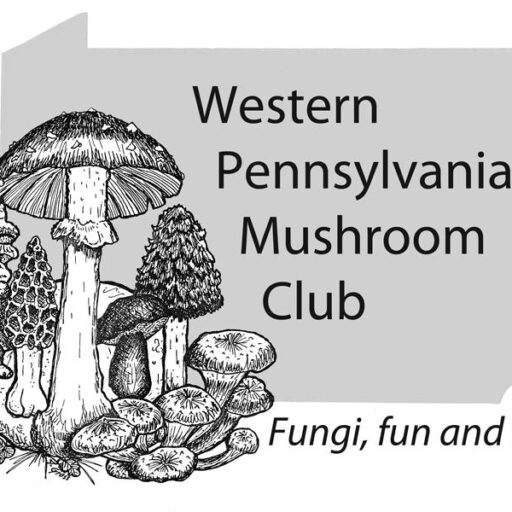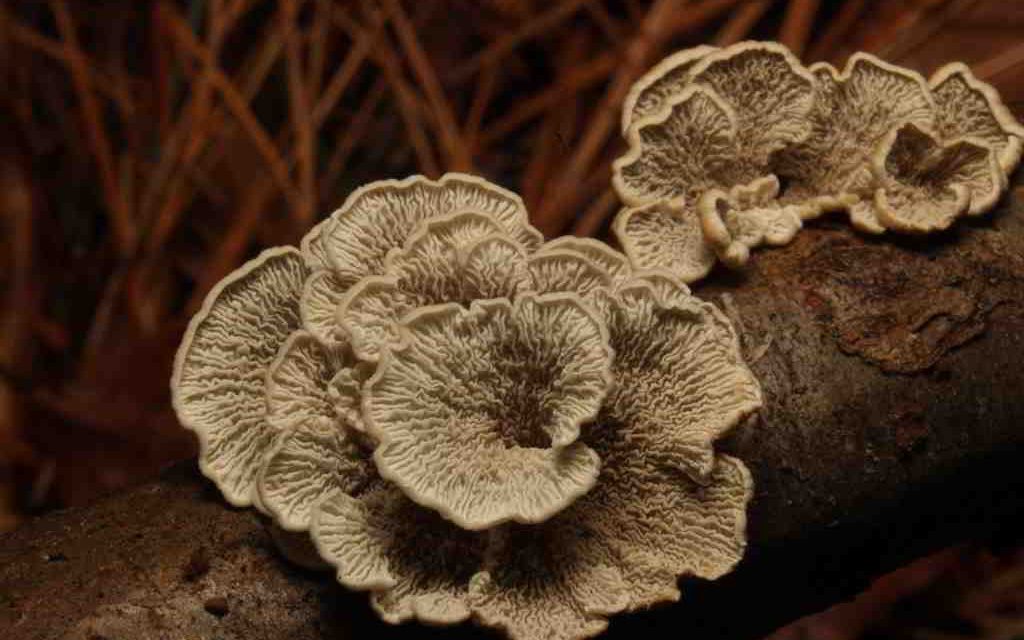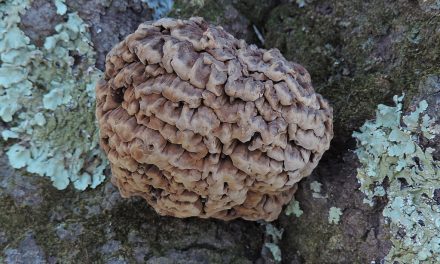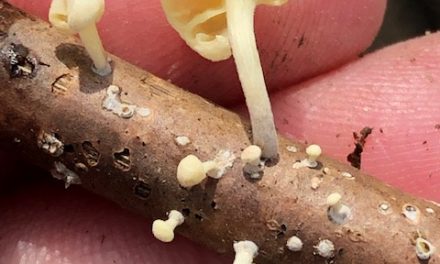Another warm Black Friday saw a group of intrepid social distancing mushroom hunters meet at Hartwood acres to see what bargains we could find. With only a couple of days of frosts in the weeks before Black Friday there were high hopes for a wide range of species including some terrestrial gilled mushrooms. The group split with Cara Coulter and some hunters exploring the conifer section of Hartwood Acres to the north of the mansion and the main group visiting “Mushroom Valley” to the south. Meanwhile Judy Mackenroth went for a very socially distanced solo walk and contributed her list to this report.
In 2016 we found a rarely observed Clitocybe cokeri but hadn’t seen it since. This year I’m pleased to announce that we found it again. In the intervening time it has undergone a name change so is now know as Pseudoomphalina cokeri. On iNaturalist there is only one other site in the US where it has been identified we presume it is a more common but overlooked species.
There were quite a few new to the club species. One of them is a mushroom (or mold) that grows on another mushroom. The species is Epicoccum nigrum and it grows on old puffballs and was found and identified by Judy using club mycologists John Plischke III book. We found another mushroom mold growing on the base of a Clavulina coralloides (White Coral Fungus) specimen, Helminthosphaeria clavariarum, it’s also in John’s book. We found a Multiclavula mucida (White Green-algae Coral) specimen in the mushroom valley. It’s an interesting species as it forms a symbiotic relationship with algae although it is not a lichen. Most fungi that form relationships with algae are Ascomycota but Multiclavula mucida is a Basidiomycete. Judy found a related species, Multiclavula corynoides, that is new to the club. It has a club like head rather than a straight club shape. A new to the club mycena species was identified by Cara Coulter, Mycena griseoviridis, along with one that is known. Mycena epipterygia (Yellow-stalked Fairy-helmet). The Mycena epipterygia is quite fun as it was very sticky. Both were in the conifer section of the woods. Cara also found Rhizomarasmius pyrrhocephalus, a marasmius like small mushroom with a dark colored tough and long stem, almost like a rhizomorph. Last of the new species that I am going to mention was Xylodon paradoxus a crust mushroom that at first glance you might think is Irpex lacteus, the Milk-white Toothed Polypore. On closer inspection you can see that it it is actually interesting shaped pores rather than tooth pores of Irpex lacteus, hence the common name Split Porecrust. Another way to differentiate them is that Irpex lacteus tends to have cap-like margins that extend beyond the substrate while Xylodon paradoxus does not.
If you were playing the fall bingo the walk would have been a great way to add to the board. We found 16 of the 25 species in one walk. Sadly you would not have been able to score a bingo.
And of course there was a selection of unidentified species on the table too.
Species list entered by Richard Jacob. Identifications by Cara Coulter, Richard Jacob, Judy Macenroth and others.
List of species found on the walk at Black Friday walk at Hartwood Acres:
[icon style=”camera”] Apioperdon pyriforme ( Pear-shaped Puffball ),
[icon style=”camera”] Armillaria gallica (Honey Mushroom),
[icon style=”camera”] Ascocoryne sarcoides (Purple Jelly Drops),
[icon style=”camera”] Bisporella citrina (Yellow Fairy Cups),
[icon style=”camera”] Bjerkandera adusta (Smoky Polypore),
[icon style=”camera”] Cerioporus squamosus (Dryad’s Saddle, Pheasant Polypore),
[icon style=”camera”] Cerrena unicolor (Mossy Maze Polypore),
[icon style=”camera”] Clavulina coralloides (White Coral Fungus),
[icon style=”camera”] Clitocybe fragrans (Fragrant Funnel),
[icon style=”camera”] Crucibulum laeve (White-egg Bird’s-nest Fungus),
[icon style=”camera”] Diatrype stigma (),
[icon style=”camera”] Exidia crenata (Brown jelly roll),
[icon style=”camera”] Exidia glandulosa (Beech jelly roll),
[icon style=”camera”] Flammulina velutipes (Velvet foot; Enokitake),
[icon style=”camera”] Fuscoporia gilva (Mustard Yellow Polypore),
[icon style=”camera”] Galerina marginata (Deadly galerina),
[icon style=”camera”] Ganoderma applanatum (Artist’s Conk),
[icon style=”camera”] Ganoderma curtisii (),
[icon style=”camera”] Ganoderma lobatum (Soft Artist’s Conk),
[icon style=”camera”] Gloeoporus dichrous (),
[icon style=”camera”] Grifola frondosa (Hen of the Woods / Sheep Head),
[icon style=”camera”] Helminthosphaeria clavariarum (),
[icon style=”camera”] Hygrophoropsis aurantiaca (False Chanterelle),
[icon style=”camera”] Hymenochaete rubiginosa (Oak Curtain Crust fungus),
[icon style=”camera”] Hypholoma lateritium (Brick top),
[icon style=”camera”] Hypoxylon fragiforme (Red Cushion Fungi),
[icon style=”camera”] Ischnoderma resinosum (Resinous Polypore),
[icon style=”camera”] Laetiporus sulphureus (Chicken Mushroom; Sulphur Shelf),
[icon style=”camera”] Lycogala epidendrum (Wolf’s Milk Slime),
[icon style=”camera”] Merulius tremellosus (),
[icon style=”camera”] Multiclavula mucida (),
[icon style=”camera”] Mycena epipterygia (Yellow-stalked Fairy-helmet),
[icon style=”camera”] Mycena subcaerulea (Blue mycena),
[icon style=”camera”] Nectria cinnabarina (Coral Spot Fungus),
[icon style=”camera”] Neofavolus alveolaris (Hexagonal-pored Polypore),
[icon style=”camera”] Panellus stipticus (Luminescent Panellus, bitter oyster),
[icon style=”camera”] Peniophora albobadia (Giraffe spots),
[icon style=”camera”] Phaeotremella foliacea (Jelly Leaf),
[icon style=”camera”] Phlebia incarnata (),
[icon style=”camera”] Phlebia radiata (),
[icon style=”camera”] Pleurotus ostreatus (Oyster Mushroom),
[icon style=”camera”] Plicaturopsis crispa (Crimp gill),
[icon style=”camera”] Pseudoomphalina cokeri (),
[icon style=”camera”] Pycnoporus cinnabarinus (Cinnabar Red Polypore),
[icon style=”camera”] Radulodon copelandii (Asian beauty),
[icon style=”camera”] Radulomyces paumanokensis (),
[icon style=”camera”] Sarcomyxa serotina (Late Fall Oyster),
[icon style=”camera”] Serpula himantioides (),
[icon style=”camera”] Stereum complicatum (Crowded Parchment),
[icon style=”camera”] Stereum ostrea (False Turkey-tail),
[icon style=”camera”] Trametes betulina (Multicolor Gill Polypore),
[icon style=”camera”] Trametes gibbosa (Lumpy bracket),
[icon style=”camera”] Trametes hirsuta (),
[icon style=”camera”] Trametes versicolor (Turkey-tail),
[icon style=”camera”] Trichaptum biforme (Violet Toothed-Polypore),
[icon style=”camera”] Tubaria furfuracea (Fringed Tubaria),
[icon style=”camera”] Xylaria polymorpha (Dead Man’s Fingers),
[icon style=”camera”] Xylobolus frustulatus (Ceramic Parchment)
Species not currently on clubs life list:
Epicoccum nigrum
Heterobasidion annosum
Multiclavula corynoides
Mycena griseoviridis
Rhizomarasmius pyrrhocephalus
Xylodon paradoxus
Agaricus sp. possibily Agaricus sylvaticus (Blushing Wood Mushroom) but still working on it
Chlorphyllum sp.
Coprinellus sp.
Coprinopsis sp. possibly Coprinopsis lagopus but would have needed microscopic analysis to confirm.
Dacrymyces sp.
Gymnopilus sp.
Pluteus sp.
Postia sp.
Phycomyces sp.
Pictures by Cara Coulter, Richard Jacob, Sara Klingensmith and Judy Macenroth













































Recent Comments